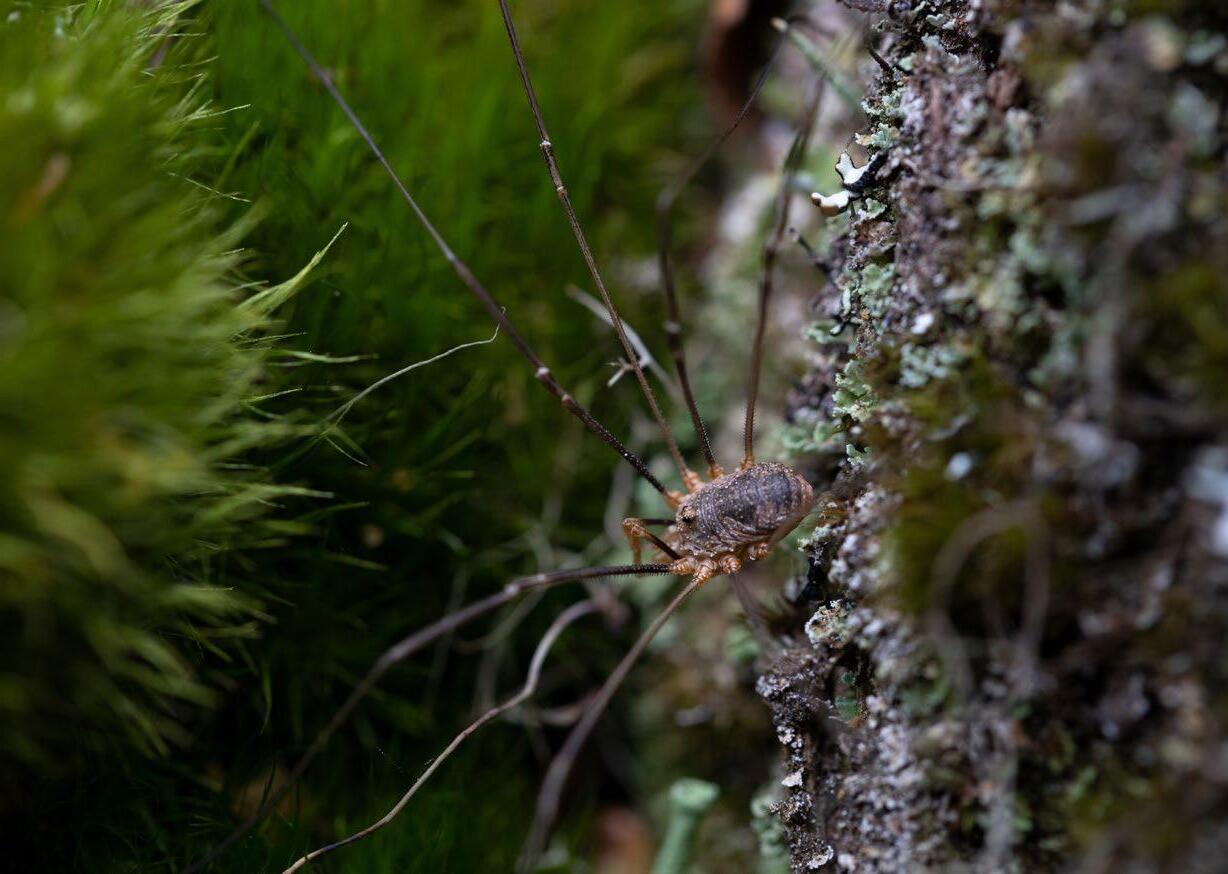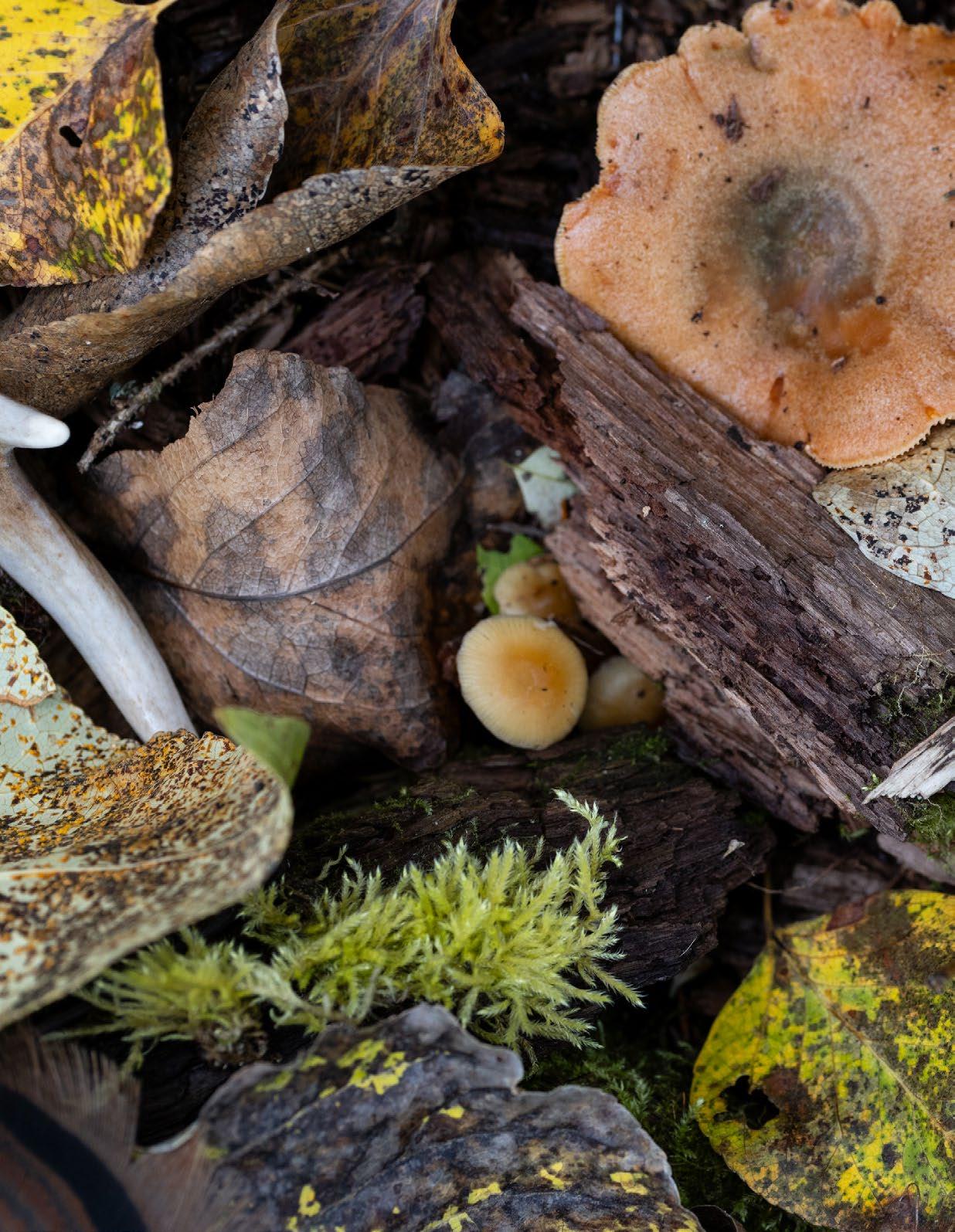The Confluence


Fall 2023






The mountains are backlit by morning light as I sit down to write, coffee in hand. Dawn comes a little later these days, and there’s a gentle urgency to soak up every last bit of sunlight as it spills over the ridgelines and flows slowly across the valley floor. Hillsides in the high country are fringed with red huckleberry leaves and the rusty stalks of fireweed, their sun-dried seed pods spread wide to release next year’s growth. The last tendrils of western Montana wildfire smoke have faded into steely skies, and water courses through the land at a slower clip.
There’s a special place in my heart for the in-between seasons, when days are a mixture of wool layers and short sleeves, and winter squash ripen beneath the last of the tomatoes. There’s a shift in the pace of things this time of year, from fast, far-flung summer adventures, to a slower way of being in the world. This is the wandering season, marked by the scent of bar oil and sawdust and freshly cut firewood, and the taste of last season’s harvest, as we wash canning jars and make room in the freezer. It’s a time of lasts and firsts - the last farmers’ market and the first frosty morning, the last dip in an alpine lake and the first fire in the wood stove, the last night with the windows wide open and the first dusting of snow on the peaks.
It’s easy to mourn the long, warm days of summer, and (like many of us) I’m not always ready to embrace the cold; but the truth is, I love this time of year. I love its immediacy and quiet disregard, its permissionless transformation of place and unapologetic undoing of plans. It feels like the season itself is an invitation to slow down, check in, catch up, and reflect.
So, let’s take some time to do just that. This summer has been anything but slow for SVC, with two college programs, the first-ever backcountry Master Naturalist course, the annual Swan Valley Bear Resources Bear Fair, a gathering at The Nest on Swan River to connect with one another and raise funds to support SVC’s scholarship program and work moving forward, and so, SO much more in between. Every single thing that filled our calendar this summer was made possible by the dedication, passion, expertise, and energy of SVC’s incredible staff, and there’s nowhere near enough room here to adequately thank them for the work they do every single day.
Summer also brought the bittersweet experience of leaning into the process of finding new leadership, as we prepare to wish Rebecca all the best on her next adventure. Like saying goodbye to the warmth and light of summer, it’s not easy to say goodbye to someone who’s brought so much growth and nourishment to the organization. However, Rebecca’s leadership and vision over the past six years has prepared all of us at SVC to move into the next season with greater hope, resiliency, and passion.
Altogether, summer’s been full and rich and wild, much like the landscapes that shape us all. I hope this issue of The Confluence finds you well in the shifting seasons. I hope its pages are stained with early morning coffee and splatters of freshly-made applesauce, or dog-eared while you step outside to soak in the rays of late season sunlight. I hope the spaces in between collect dirt from fall harvests and a golden larch needle or two as the days grow colder, or (as in my case) hairs from the sweet pup curled up next to you on the couch. Thanks to each of you for being part of the SVC community.
Happy Wandering,
Below: Chainsaw and Barred Owl illustration by Jessy for This is Wildfire, a book about “how to protect yourself, your home, and your community in the age of heat.” See more illustrations and learn more about the book and its meaning to Jessy on page 14.
 Jessy Stevenson, Board of Directors Vice-Chair
Jessy Stevenson, Board of Directors Vice-Chair
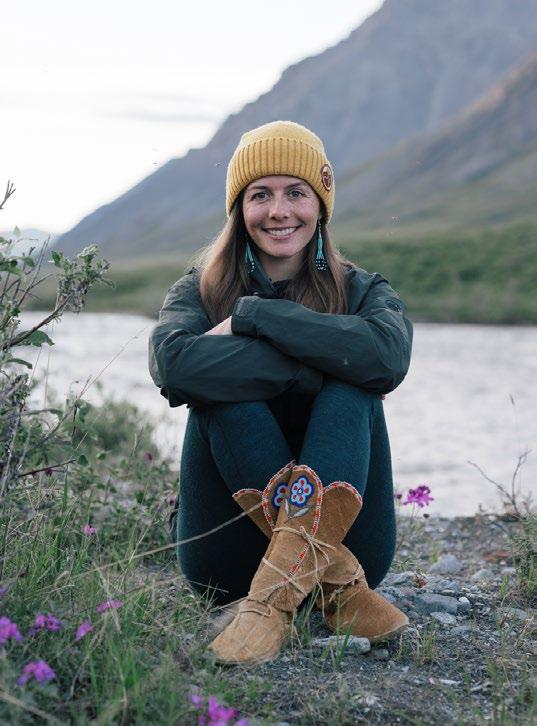
Swan Valley Connections
6887 MT Highway 83
Condon, MT 59826
p: (406) 754-3137
f: (406) 754-2965
info@svconnections.org
Board of Directors
Mary Shaw, Chair
Jessy Stevenson, Vice-Chair
Donn Lassila, Treasurer
Kathy DeMaster
Rachel Feigley
Steve Kloetzel
Zoë Leake
Casey Ryan
Dan Stone
Greg Tollefson
Aaron Whitten
Tina Zenzola
Emeritus
Russ Abolt
Anne Dahl
Steve Ellis
Neil Meyer
Advisors
Kvande Anderson
Steve Bell
Jim Burchfield
Larry Garlick
Chris La Tray
Tim Love
Alex Metcalf
Pat O’Herren
Mark Schiltz
Mark Vander Meer
Gary Wolfe
Staff
Rebecca Ramsey, Executive Director
Andrea DiNino
Luke Lamar
Sara Lamar
Mike Mayernik
Alex Morrow
Jackie Pagano
Uwe Schaefer
Taylor Tewksbury
The Confluence is published by Swan Valley Connections, a non-profit organization situated in Montana’s scenic Swan Valley. Our mission is to inspire conservation and expand stewardship in the Swan Valley. Images by Swan Valley Connections’ staff, students, or volunteers, unless otherwise noted. All rights reserved to Swan Valley Connections. Change service requested.
SwanValleyConnections.org
Thank you to those of you who were able to join us for our annual Summer Soirée in the Swan this past August, and to those of you who supported us in person and online!
We had such a wonderful time celebrating the impacts of experiential education in the Swan with you all; so much so, that we’ve already scheduled our event for next year!
Summer Soirée in the Swan
The Nest on Swan River Sunday, August 25, 2024
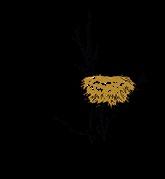
Enjoy appetizers by Forage, spirits from Glacier Distilling, beautiful florals by Cranky Goose Farms, and live music by Jessie Thoreson and the Crown Fire!
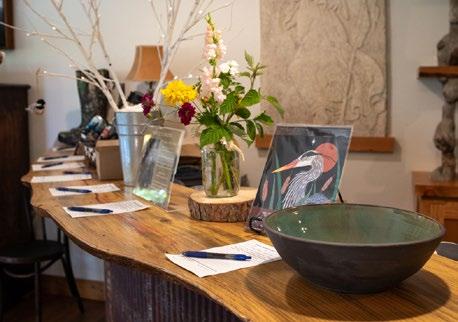
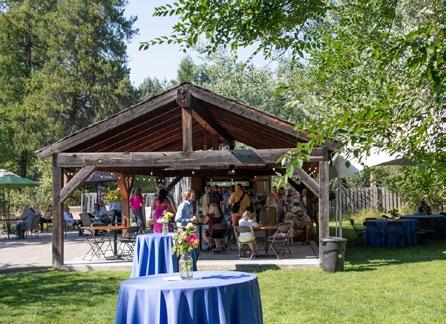


(Jessie is an alumna of SVC’s Landscape & Livelihood field program; check her out on Spotify, YouTube, Instagram and more!)
We are thrilled to welcome Aaron Whitten (he/him) to our Board of Directors!
Aaron and his partner Chiaveli own the Timbers Motel in Bigfork, Montana. And they’re also alumni of our Montana Master Naturalist course, in which they earned their naturalist certifications.

It could be seen from outer space. Satellite imagery clearly showed the contrast between other public and private forest ownerships and the unsustainable logging practices and clearcuts that Plum Creek Timber Company had become known for. The checkerboard pattern across the landscape led to a decrease in wildlife connectivity and habitat values. An elaborate and extensive system of logging roads had been created to reach every corner of land and seemingly every tree, and with heavy rains led to runoff that choked the streams and native fish with fine sediment. Weeds established along these roads and slowly grew to infest the disturbed lands, affecting all forms of native species, plant and animal. If that wasn’t enough of an ecological catastrophe, back in 1999, unsettling news started circulating around the valley. Plum Creek Timber Company, who owned nearly every other section of land in the Swan Valley (67,000 acres total), announced that it had reorganized into a real estate investment trust (REIT). Places that I had grown accustomed to having free access to hunt, fish, pick huckleberries, gather firewood, hike, and explore suddenly had the possibility of becoming private property with “no trespassing” signs and no public access. Those thoughts paled in comparison to what could become of the land, and the Swan Valley’s wild and pristine landscape, rural character, outdoor economies, wildlife habitat, and sensitive wildlife species, if every other section of land was developed or ended up as a subdivision.
Over the next few years, a few square sections (1 section = 640 acres) of Plum Creek land in the Swan Valley were sold to private landowners, foreshadowing the start of what could have become a conservation nightmare. A few small conservation victories were won; Swan Ecosystem Center and the Confederated Salish and Kootenai Tribes successfully purchased and conserved what is now known as the Elk Creek Conservation Area in 2006 for a hefty price tag of $9.6 million (a story for another newsletter). This parcel was deemed to be one of the highest value Plum Creek lands, largely due to its wildlife habitat values, and because Elk Creek was one of
the premier bull trout spawning streams in the Swan. As important and significant as the land conservation purchase was, it highlighted the fact that conservationists couldn’t save the Swan by purchasing one section of land at a time, and in some ways was the precursor for focusing on a larger land conservation deal.
Seemingly against all odds, the impossible was made possible. Along with The Nature Conservancy and Trust for Public Land, a list of conservation heroes worked tirelessly behind the scenes, including founders of SVC’s parent organizations Northwest Connections (Melanie and Tom Parker) and Swan Ecosystem Center (Anne Dahl), to ultimately bring to fruition the largest land conservation deal in Montana’s history.
In 2007, The Nature Conservancy and Trust for Public Land entered into an agreement with Plum Creek Timber Company to purchase its remaining lands in the Swan Valley. This was part of a larger land conservation deal that bought out 320,000 acres of Plum Creek lands in western Montana, known as the Montana Legacy Project (MLP).

For being the largest land conservation deal in Montana’s history, there was surprisingly little celebration. There were no boisterous parties, formal celebrations, parades, or banners lining the highway; no groups with floats in the 4th of July parade touting preservation of the Swan Valley’s rural way of life, the protection of valuable wildlife habitat and connectivity, and maintenance of public access to hunting, fishing, and recreation on these lands.
In hindsight, at a cost of $510 million, the MLP was a good deal and was money well spent. The Nature Conservancy slowly divested itself of the lands and, in the Swan Valley, these largely ended up in U.S. Forest Service and Montana Department of Natural Resources and Conservation management. This helped to preserve the outdoor legacy by protecting forest ecosystems from development, preserving valuable wildlife habitat and connectivity, and maintaining accessibility for hunting, fishing, and recreating, all while sustaining rural, working jobs and forestry practices. Taxpayers aren’t burdened with paying to extend services into the forest fringe that otherwise would have occurred.
TNC’s Western Montana Land Steward (and SVC Board member!) Steve Kloetzel played an integral role with the MLP transaction and land management until the parcels were transferred to public ownership. Steve reflected on the conservation feat, articulating, “Given that Plum Creek Timber Company could have easily sold this land off as over 400 160acre lots, which could have been easily further subdivided into 1,600 40-acre lots, or even smaller lots…well, frankly, it is almost impossible to overstate the impact this would have had on public access and recreational use, and the ecological health and ecosystem function of the Swan watershed. Since TNC’s complete transfer of these lands to public land management agencies by 2015, public access has been permanently secured, critical fish and wildlife habitat is protected and enhanced, and forests can be managed on a landscape-scale basis.”
With the unprecedented explosion in outdoor recreation the past few years, increased turnover of residents and properties, and potential for new corporate interests to buy out and change the places we’ve grown accustomed to, it’s understandable that folks who have been here all their lives, or at least long enough to be considered “a local,” have a bit of animosity about these changes. I hear a lot of comments like, “If that person doesn’t like the way it is here, why don’t they move back to where they came from?” or “Why do people move here and try and change it to be like the place they came from?” or “Why can’t they go recreate somewhere else?” Now take a moment and imagine what this place would have become if Plum Creek had slowly sold every other square mile of land to the highest bidder. 67,000 acres of places you and I go pick huckleberries, harvest a winter’s worth of firewood, hunt, fish, hike, camp, and recreate on might have “no trespassing” signs, more fences delineating each property boundary, subdivisions, and second home trophy mansions, not to mention more people living here, recreating, and impacting the remaining public land resources that we all enjoy.

What are some of our favorite places that used to be Plum Creek lands, and that could have been forever altered and turned into private property with no public access? Try the favorite local swimming and fishing hole and gravel beach on the Swan River at the Cold Creek Road bridge. Jim Lake could have had a mansion on its shores, with “no trespassing” signs blocking precious access to the lake and the basin in the Mission Mountains Wilderness to the west. There would be no more snowmobiling or backcountry skiing up on Red Butte. There would be no more hunting for the elusive big buck or bull every year on certain Notellum Ridges and Nunya Basins, just to name a few.
While a new generation is enjoying the Swan Valley’s lakes, streams, trails, and wild lands, we should never forget the conservation heroes that fought to bring the MLP to fruition, and what could have been. So, while maybe we don’t live in a perfect world, where it seems some people can’t be happy unless they have something to gripe about, the next time you’re about to explode on some out-of-stater fishing in your spot; driving too fast on the dusty road; a new home being built; that new, ugly fence that isn’t wildlife friendly; your new neighbor that doesn’t realize all those beautiful purple flowers that are actually weeds; or that corporation that is going to build something drastic; just stop and remember how lucky we are to live, work, and play in such a beautiful, wild valley with such an incredible legacy of conservation that we all have benefitted from and enjoy.
Let’s help our new neighbors understand the conservation legacy of the Swan Valley and the importance of being a good steward to the land; why everyone should contain their garbage in a bear-resistant trash can to keep the bears from getting habituated to human foods; why it’s important to leave natural vegetation along the stream banks to protect from erosion and benefit native fish; why it’s important for wildlife, water quality, and humans to protect healthy wetlands and not drain or dredge them; and why that bottom strand of fence wire is preferably 18 inches off the ground and top wire a maximum of 40 inches high to ensure safe wildlife passage (or the value of having no fence at all if one’s not needed). Let’s help folks understand the negative impacts that field of orange hawkweed has on wildlife and the resources available to help eradicate it. Let’s show new folks the friendliness that the Swan has always been known for. Let’s never forget our responsibility to protect, preserve, and respect one of the most ecologically diverse and intact biological systems remaining in the world.
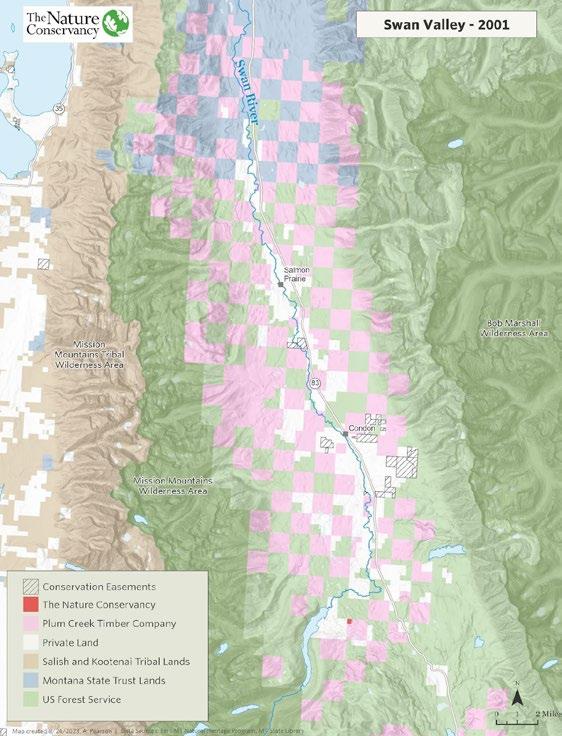
Tonight’s mission was the same as the missions of countless other nights: go to the surface, steal a cow, and get out of there before being spotted. After this many runs of the mission, Dion was sure he had the hang of it, so sure that he was perhaps a little overconfident.
Maybe a lot overconfident.
So overconfident that his ship got tangled in the fence.
How did he manage this? He didn’t know. He’d thought he was good at piloting this thing with only one eye, so good that he’d never bothered to get a replacement eye the handful of times he went home to Rhythm City.
But no.
Apparently he wasn’t that good at flying the Bovine Snatcher 9000.
Dion sighed a static-filled sigh and moved to the airlock to inspect the damage. As soon as he opened it, it occurred to him the ship was lying sideways and that it would be very easy to fall out. By the time he realized what falling out would entail, he was already stuck in the electric fence himself.
The key word here was electric Dion was made of metal alloy. Dion had many, many circuits just waiting to be fried by some human rancher’s fencing.
And they absolutely got fried.
The more Dion struggled, the more tangled in the fencing he got and the worse the damage got. Supposedly the voltage on these wasn’t even that high, but if you were made of metal, any voltage was too–
Dion’s processor cut out. ***
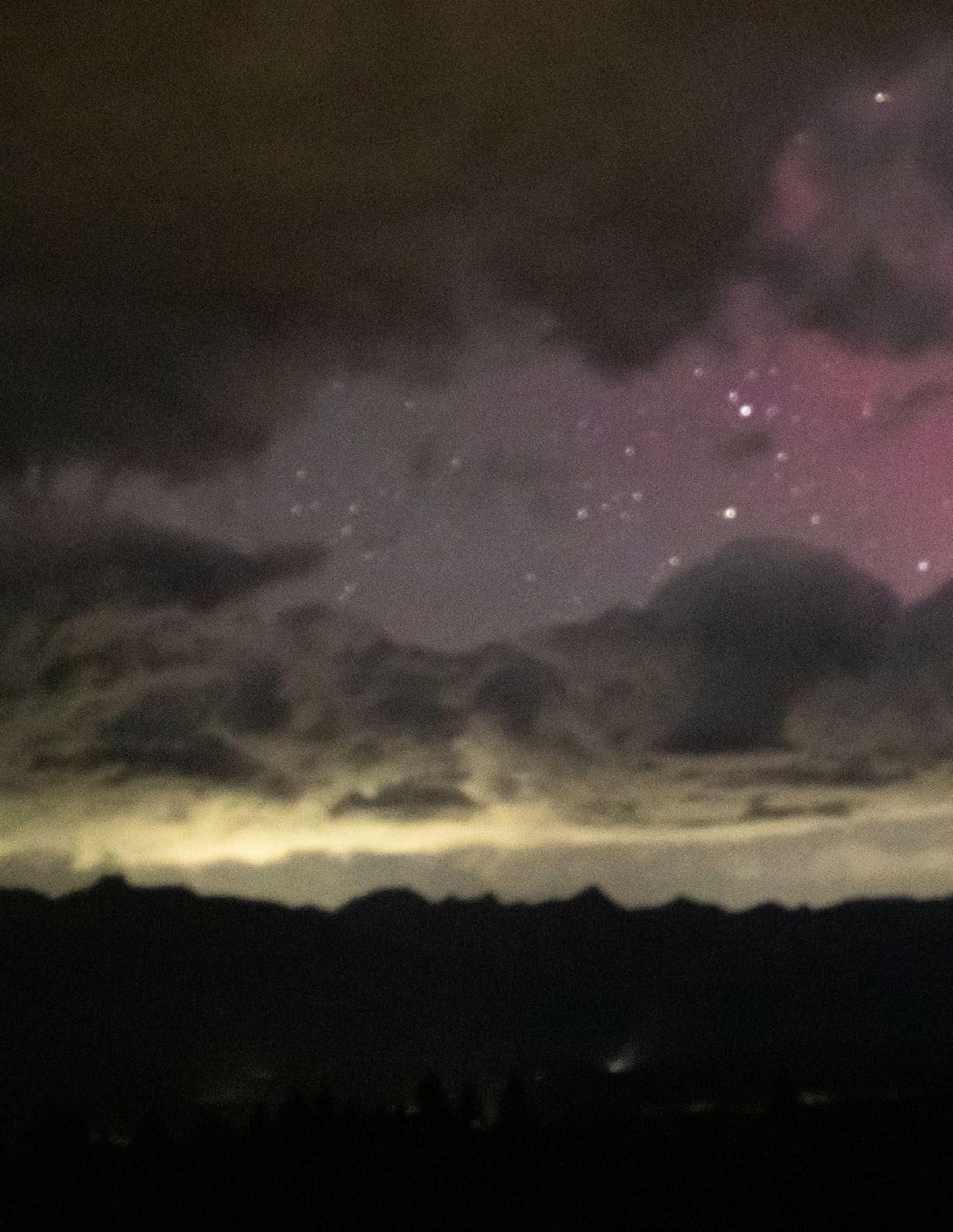
And seeing how he was stuck in a fence, there might be an opportunity right here.
“Why should I let you out?” the organic said, and Dion still couldn’t see it because it was standing behind him, probably with a gun. “Your ship is right there. Clearly you were trying to steal more of my cows.”
More of?
WE MAKE. AN ATTEMPT. TO TARGET. ALL FARMS. EQUALLY. TO MITIGATE. THE POTENTIAL. TO DRAW. ATTENTION.
“Well, it’s a poor attempt,” the organic said. “I’ve lost ten cows to you this year.”
HOW DO. YOU KNOW. IT WAS ME?
“Because I saw your ship, Tin Man,” the organic said. NOT TIN MAN. DION.
“Fine, Dion,” the organic said. “Call me Kane. Where are my cows and what do you want with them? If you explain yourself, I might just help you get out of that fence.” PUT DOWN. THE GUN.
“This isn’t a gun,” Kane said. “This is a USDA certified organic carrot.”
AS OPPOSED TO. A USDA CERTIFIED. MECHANICAL CARROT?
Kane seemed to let its guard down a little bit and it laughed. “My whole operation here is organic, everything from the carrots to the cows you steal. Is that why you want them so bad? Does organic beef draw in a huge profit on Mars?”
I AM NOT FROM MARS, Dion said, and the words were coming out more smoothly now. I AM FROM RHYTHM CITY.
“And what does Rhythm City want with my cows?” Kane said.
“Hello?” a voice said, and it one hundred percent did not belong to an android.
Dion slowly opened his eye to see the night sky staring back at him with all its stars. He was upside down. He struggled to right himself but was still tangled in the fence, and he heard the same organic voice say, “I turned off the fence.” BUT YOU. DIDN’T THINK. TO GET ME. OUT OF IT? Dion said, and the words were strange on his vocals because this was the first time he’d spoken any Earthling language. He’d downloaded the entire English language from Rhythm City’s Earth database as soon as this organic spoke, but that didn’t grant him any comfort with it. The words were clumsy and slow and they would continue to be clumsy and slow until Dion had more opportunities to practice.
FUEL SOURCE, Dion said.
“For what?” Kane said.
I AM NOT GOING TO EXPLAIN THE CONDITION OF MY PLANET TO A STRANGE CREATURE THAT IS THREATENING ME WITH A USDA CERTIFIED ORGANIC CARROT.
“I’m not threatening you with this carrot,” Kane said. “I’m eating it.”
Crunch.
“Given your hesitation to discuss the condition of Rhythm City with me, I’m assuming it’s in bad shape,” Kane said. “Why else would you travel this far to take resources from another planet?
Those are quantum engines on your ship, after all. Must be quite the desperate jump you have to make.”
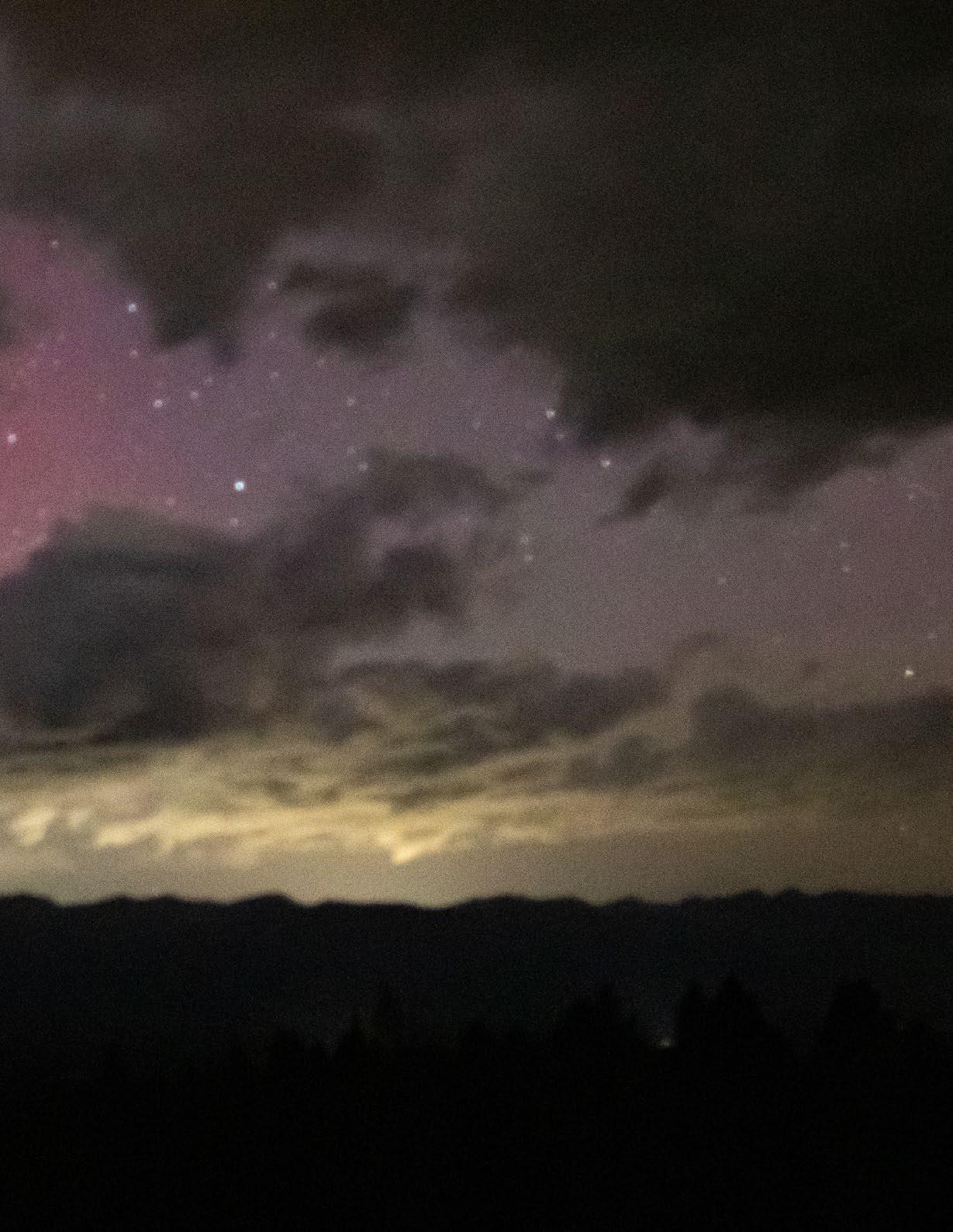
“I’ve read my fair share of science fiction,” Kane said. “Though I’m doubting the fiction part now, seeing how I’m looking right at a cow-stealing alien and all.”
Kane jumped over the fence and kept eating its carrot, and now Dion could see it. It was unremarkable. Hairless, like all humans were. Wearing a coat to keep it warm. A hat. A scarf.
Worn-out boots with mud on them. It had lots of scratches on its skin from thistles and thorns, and on its face were some patches of healing sunburn. This was a creature that spent a great deal of time outdoors connecting with the land around it. Every farmer was like that, going off the descriptions Dion got from other collectors in Rhythm City. Farming was hard work. They had to love the land they worked on.
Love for the land. That was a foreign concept.
A foreign concept that could’ve saved Rhythm City from becoming Rhythm City in the first place. After all, until the factories and the smoke and the skyscrapers and the countless corporate towers, it was called the Rhythm Lands, and it was beautiful. Clean rivers that rushed through the mountains and valleys, green trees that made rich forests, lush meadows with bright flowers and buzzing honeybees—all of it was so beautiful.
And gone. So far gone.
A loud crunch from Kane’s carrot brought Dion’s attention back to it, and Kane said, “You look sad.”
I DO NOT WASTE TIME GRIEVING FOR WHAT I CAN NEVER HOPE TO BRING BACK, Dion said.
“Your planet ran out of resources, didn’t it?” Kane said. “That’s why you come here to Earth. You need a fuel source because there is no longer a fuel source of any kind on your own planet.”
I SAID NOTHING OF THE SORT, Dion said.
But Kane was right.
Rhythm City had no resources left.
Every last bit of coal had been mined and thrown into the furnaces of the factories. Every last tree had been cut down and turned into a governor’s desk, a senator’s doorframe, a mayor’s chair. The soil was dry and lifeless, the wind still and silent, the animals nothing more than bleached bones on the barren ground. And the sun?
Rhythm City’s beautiful sun? The sun was gone.
Humans would say draining a star of its power wasn’t possible, but technology on Rhythm City was so far advanced that the androids were able to do just that. The sun was contained, the sun was controlled, and the sun was used up. Completely. Used. Up.
And what did that leave Rhythm City with? Nothing. Nothing at all.
Dion looked away. I TAKE YOUR COWS BECAUSE OUR GOVERNMENT WANTS TO CONVERT ORGANIC MATTER INTO POWER: POWER FOR THE CITY’S BUILDINGS, BUT MOST IMPORTANTLY, POWER FOR THEMSELVES.
“So of the cows you steal and convert into power, however you do that,” Kane said, “you don’t get any of that?”
I GET NOTHING, Dion said. I AM A COLLECTOR. THE ONLY WELL-POWERED ANDROIDS ON RHYTHM CITY ARE THOSE IN THE GOVERNMENT.
“It can often look that way here too,” Kane said. “I do my best to keep the money from this operation in the community.” THAT IS ALLOWED?
“Yes,” Kane said. “How about I tell you about it after you’re out of that fence?”
YOU
“Something tells me you wouldn’t steal cows if your living situation didn’t demand it,” Kane said.
IT IS QUITE MORE THAN A LIVING SITUATION, Dion said.
He left it at that and watched Kane untangle him from the fence. When he was out, Dion looked over at his ship, which was still stuck, and before he could say anything, Kane cut the ship free. “The fence needs to be redone anyway,” it said. “I would guess the ship costs a little more.”
Dion looked at his ship again and contemplated leaving right now. He didn’t have to stay here and listen to anything Kane had to say. Now that he was out of the fence, he was free to go back to Rhythm City andHm.
Free to go back to Rhythm City? He didn’t have a choice.
So Dion didn’t go to the ship just yet. He stayed and listened
to Kane tell him about organic beef, how she had her own processing plant in town, how she sold the beef locally, how every step of the process was her own. This wasn’t the way it normally happened. Usually there was a commercial processing plant involved, and there were only a few of those in the country, and once your cows went there, they weren’t your cows anymore. Once they were sold off, your job was done and you worried about raising the next batch of cattle. Where was the beef going? You had no idea. Some big grocery store on the other side of the country, maybe. And most of the time that beef wasn’t organic because organic certifications were so expensive to obtain in terms of both time and money.
“Being a local beef business is hard,” Kane said, “but I want people in this community to know where their beef is coming from. And I don’t want big corporations involved.”
I DON’T EITHER, Dion said, though he was referring to the big corporations that had ended up ruling Rhythm City. All these political titles were thrown around, governor and senator and mayor and the like, but no one was elected. Every last government official was some dirty businessman or chosen by a dirty businessman.
“Most of all,” Kane said, “I do this because I care about the planet. Big feedlots, big factories, big corporations, all of that isn’t sustainable. We need small farms and local markets. We need to mitigate our tendency as humans to build bigger and bigger until we collapse on ourselves. Better yet, we need to stop that entirely.”
IF A FAR MORE ADVANCED SOCIETY OF ANDROIDS COULD NOT PULL THAT OFF, Dion said, WHAT HOPE DOES HUMANITY HAVE?
“Operations like this,” Kane said. “Small farms like mine. People like me are gonna keep doing what we’re doing, and that’s all we really can do.”
She sat on the grass and ran her hands through it. “We’re gonna keep being people who care about the land we work on. Corporations can’t do that, but maybe if enough individual people do, things might turn around.”
YOU HAVE HOPE I LOST A LONG TIME AGO, Dion said. Kane smiled. “Maybe that gives me a chance.”
DO NOT HOLD ON TO MAYBES, Dion said.
“That’s all you really can hold onto,” Kane said. “I could always lose cows. I could always lose crops. But maybe I won’t. Maybe enough cows will survive to be sold. Maybe enough carrots and wheat and potatoes will make it. As a farmer, all you have is maybes. So looking at the state of this planet and seeing maybes, that doesn’t scare me.”
YOU ARE LOOKING AT SOMEONE FROM A PLANET THAT FAILED, Dion said.
“But did you ever try?” Kane said, and Dion didn’t answer.
Kane looked up at the sky, which was, for now, still clear and not choked with factory smoke. “I will try my best and hope others do the same,” she said, “and that’s gonna be enough. It has to be.”
AND IF IT ISN’T? Dion said.
“I don’t entertain that thought,” Kane said, “because, Tin Man, what if it is?”
Dion didn’t say anything. Then he went over to his ship. He entered the airlock. He looked back.
I DO NOT BELIEVE IN HOPE ANY LONGER, he said, BUT SINCE YOU DO, YOU STRANGE, PERSISTENT ORGANIC, I HOPE YOU WILL BE ABLE TO SEE THE STARS AS WE DO NOW FOR AS LONG AS YOUR KIND LIVES.
“I’ll do my best to make it happen,” Kane said, and Dion said nothing more, only closing the airlock and heading to the control room.
He prepared to start the quantum engines, to take off into hyperspace and return to Rhythm City, but before he did that, Dion looked back at Earth one last time, back at Kane.
DEAR HUMAN, I HOPE YOUR BEST IS ENOUGH.
Then Dion’s ship was gone and all that remained was an expanse of glittering stars, shining in a sky that was, for now, still clear.

Atlas Breighner is a Meteorology and Geography double major at Virginia Tech University. Upon completing his degrees, he hopes to conduct research pertaining to climate, including how mountains and their ecosystems are changing over time. (Selfishly, we also hope Atlas continues his creative writing.)


The Swan Valley Facebook group was relatively quiet this summer, at least when it came to bear sightings. Other than a grizzly sow and her cubs who were taking advantage of the vehicle-struck deer by Liquid Louie’s, bears seemed to mostly stay away from homes and humans and out of trouble in the Swan. Part of this may be thanks to our bountiful berry season, allowing bears to enjoy their natural foods without the pressure of finding other calorie sources.
But as we enter into hyperphagia, a season of increased caloric consumption for bears, the likelihood for human-bear conflict tends to increase. It is during this time before the denning season that we put our best efforts forward to promote healthy wildlife coexistence among our shared landscape.
Chickens can be a major anthropogenic (humancaused) attractant to bears. When consuming foods with the highest caloric value is of utmost importance, it is no surprise that an easy meal of a flock of chickens may be highly appealing to a bear.
In northwest Montana, where there are over 1,100 grizzly bears in the Northern Continental Divide Ecosystem (a recovery designation area for grizzly bears that includes the Swan Valley), chickens overtook trash as the leading source of bear conflicts last year. Beyond the financial and emotional hardship of losing a flock, there is now a high risk of avian flu transmission from birds to bears, which can sadly result in fatalities.
A potent strain of avian flu (H5N1) emerged in 2022 with mutations that allow for easier transmission to domestic poultry. Since 2022, 325 commercial flocks and 514 backyard flocks have been infected, with cases spanning across 47 states (APHIS, USDA).
The most recent detection of avian flu in chickens in Montana occurred mid-April of this year. Be sure to monitor
your flock for unusual behavior and isolate any potentially infected chickens from the group.
Symptoms of avian flu in poultry can include lethargy, loss of appetite and coordination, diarrhea, nasal discharge, sneezing, reduced egg production and/or misshapen, soft eggs, and death.
The virus can remain viable in poultry feces and soil, and can still be transmissible after removal of infected individuals if new ones are taking residence, requiring proper disinfection protocols prior to acquiring a new flock. To ensure best practices contact your local county health department for adequate steps of disinfecting the area.
Last fall Montana Fish, Wildlife & Parks (MT FWP) officials were forced to euthanize three grizzly bears with avian influenza that had neurological issues, such as disorientation and partial blindness.
In addition to bears, the Department of Agriculture has detected 109 other mammal species that have been infected with avian influenza since May of 2022. It is understood that mammals can become infected with avian flu after consuming viral birds.
To prevent bears from becoming habituated to chickens, consider installing electric fencing around your chicken coop. Properly built and maintained electric fencing can deter black and grizzly bears (as well as other carnivores) from predating on a flock, and reduce the potential spread for avian influenza from backyard flocks to wildlife.
Swan Valley Bear Resources, People and Carnivores, Defenders of Wildlife, U.S. Fish and Wildlife Service, Wildlife Services, and MT FWP can assist you with electric fence installation, provide information on upkeep, and help with costshare programs to offset some of the costs of your project and materials. Please reach out if you’d like more information!
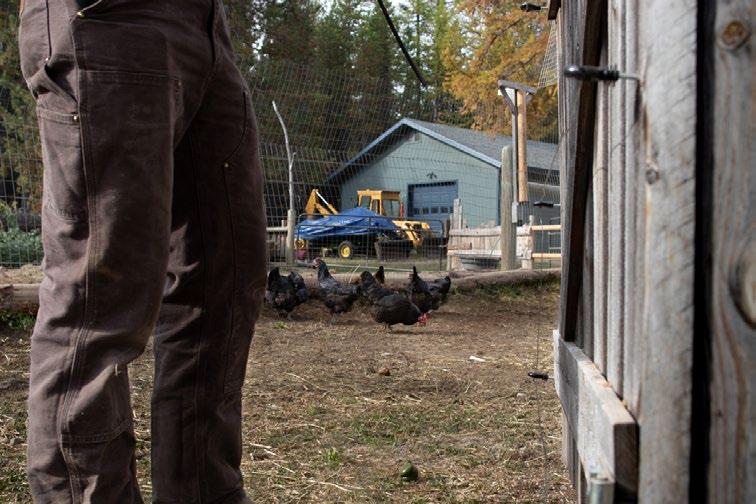
Claire Emery (born 1970, United States) is an American artist, naturalist, and educator who lives and works in Missoula, Montana. Clients include The Mountaineers Press, W.W. Norton, Orion Magazine, Glacier National Park, New York Botanical Garden, UM Fire Center, California State Parks, MT Audubon, UM Osprey Project, public & private schools across the USA.
Her current projects focus on gratitude, resilience and the relationship between personal engagement and sustainability. She promotes interrogating the values that limit our sense of vitality in our personal, political, and ecological lives.
Rather than seeing art and activism as two exclusive spheres of practice, Claire sees art as a springboard to understanding and action in community. She engages diverse strategies- collaboration, research, teaching, field work, field sketching, scientific illustration, installation, woodcuts, printmaking and mindfulness- in a practice that aims to engage the human imagination and community in personal and environmental change.
I explore the natural world with my body, my heart and my mind. Exploration is a creative act, inviting the new, the strange, the unexpected and the familiar to interact spontaneously and create new discoveries, feelings, thoughts and experiences. Simply going outside with senses open is a creative act. I go outside as often as possible.
In every kind of weather, I listen, I look, I feel, I ask questions, I reflect. Sometimes I record my observations and reflections in my field journal using sketches, diagrams, lists, poems, descriptions etc.
The practice of keeping a field journal has led me for nearly 30 years to my other creative practices such as mindfulness, carving, printing & painting woodcuts of Northern Rockies landscape communities, collaborating with scientists and conservation groups to visually communicate their work, and teaching.
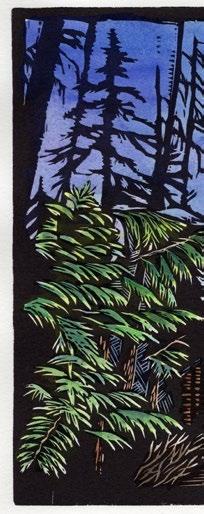
Choosing to exit buildings and move freely through the natural world with the senses wide open is the beginning of all of my work as an artist, a citizen and grateful human being.
CAN YOU SHARE AN EXAMPLE OF HOW A PARTICULAR LANDSCAPE, SPECIES, OR ECOLOGICAL RELATIONSHIP HAS INSPIRED YOUR CREATIVE PRACTICE OR SHAPED YOUR PERSPECTIVE?
From my first 10 day backpacking trip in the Bob when I was 22, I have known in my heart and soul that immersion in wild places is essential to becoming truly human and to my personal creative work.
When I work with species portraits, whether it is of a bird, a fish, plant or animal, I immerse myself in the project. I call

on all of the memories I have of seeing that being in the wild, and I look at my sketches, photos, and at books, articles, videos. For me, the root of my best work is immersion in wild places and the first-hand experiences I have had with the species I engage with. Immersion and intimacy is central to all of my best work.
I am most proud of the work I have done in community introducing people to the practice of keeping a natural history field journal. I am grateful for the sparks that have flown in people’s minds and hearts as they slow down to observe and reflect on the mysteries and majesties of our other-than human neighbors. It is always my hope that these experience together drawing, listening, writing, reflecting, will nourish a person’s agency in caring for the living landscape.
I am also proud of any successes I have had in raising money for conservation and community groups through commissions and donations of my work. My goal is to conserve and care for our local landscape community through my work as an artist and educator.
Lastly, I am proud that I helped to create a new literary field guide called Cascadia which was just printed by the Mountaineers Books in Seattle. Instead of conveying the intricacies of nature via scientific facts, this field guide introduces species by way of literature, art and poetry. So, one can get to know a creature not only by its size and color, but also by how it affects the hearts of others. A field guide like this can create a new kind of intimacy with the landscape community, building feelings of reciprocity and wonder.
“This is a guide to relationship, a gift in reciprocity for the gifts of the land.”
-Robin Wall-Kimmerer, author of Braiding Sweetgrass
The creative practice of keeping a field journal cultivates understanding, appreciation and a helpful and healing spirit. Understanding and appreciation cultivate conservation-minded people. So, let us notice and enjoy wild and working landscapes, and then let us conserve them!
In a run-away, industrial culture like ours, simply slowing down is a revolutionary act. Giving full presence to who we are with, and listening to that person, that plant, that bird, that mountain or river, is a revolutionary act.
Slowing down and paying attention transforms our relationship with ourselves, and with our places. We become more attuned, more alive, more inclusive in our understanding of how to nourish vitality at a personal and community level. The practice of keeping a field journal transforms anyone who does it sincerely.
We then stand up for our understandings and values by speaking up for what we believe in. We march, we write, we collaborate, we educate: we do all of this from a place of clarity and gratitude and humility because slowing down and paying attention have built us this way.
It is my hope that in addition to keeping a field journal, people who see my woodcuts will feel a bit of that stillness and awe within the image. For me, making a woodcut is a devotional practice. I observe, I listen, I draw, I listen, I carve, I listen, I print and I listen. I slow down and listen for the spirit of my subjects. And when I can hear them, my work has more ability to inspire people to work for what they believe in.
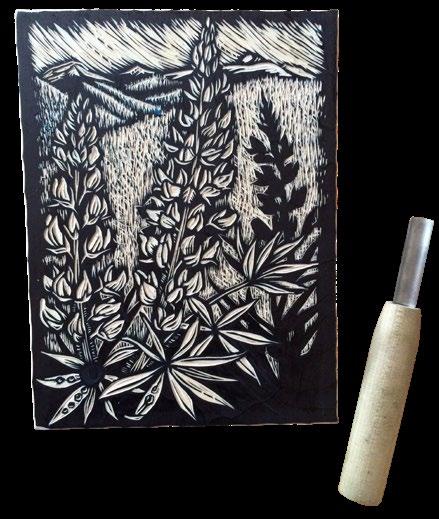
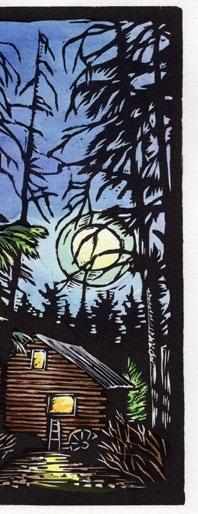

DO YOU HAVE ANY CREATIVE GOALS OR UPCOMING PROJECTS THAT YOU ARE LOOKING FORWARD TO?
My creative goals include diving into more opportunities to introduce people to the practice of keeping a field journal. I want to offer my experience to help others find vitality in slowing down, listening, observing and discovering the marvels of nature.
As I am entering Rebirth at Midlife (my children have gone to college), I am looking forward to expanding my printmaking practice through experimentation with larger, looser pieces.
And, as always, I eagerly anticipate the next conservation partnership with a group who feels my work can add to theirs.

If you are a recipient of our quarterly publication, The Confluence, then you are likely already aware of how special the Swan Valley is. It is often a challenge to find the right words to encapsulate both the true wildness of this place, and how fortunate we all are to live, work, and play on a landscape that supports one of the last intact ecosystems in the lower 48 states.
But what does “intact ecosystem” mean? According to the The International Union for Conservation of Nature (IUCN), “an intact ecosystem is represented when an ecological community has the complete complement of species known or expected to occur in a particular site or ecosystem, relative to a regionally appropriate historical benchmark, which will often correspond to pre-industrial times.” An alternative meaning has been described as “when all known species that have occupied an area are present and still functioning in their ecological roles.”
However you interpret the term “intact ecosystem,” the Swan Valley remains a rare and shining example. This working landscape exemplifies an ecological balance in large part thanks to individuals and organizations continuing to fight for the Swan to remain a wild and resilient place. This balance is supported through our abundance of public lands and our narrow, glacier-carved valley being nestled between two Wilderness designations. All this to say: not only do the human inhabitants of the Swan Valley thrive, but this environment supports robust wildlife habitat with ample connectivity.
Swan Valley Connections has worked to support the conservation of the valley’s natural resources, including the health of wildlife populations, since our parent organization’s genesis in 1997. This work has presented itself in an assortment of ways over the years. To name a few…
Our fish and wildlife research and monitoring projects have included:
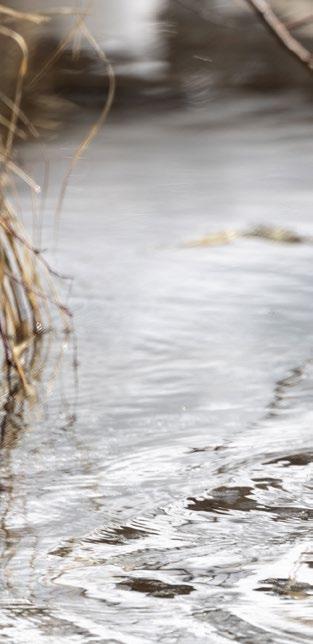
• Relative abundance, distribution, and diet analyses studies for wolverine, lynx, grizzly bear, and various others.
• Collection of genetic material of lynx, wolverine, and grizzly bear to establish baseline information such as individual identification, sex, and sub-population genetics.
• Promotion and facilitation of human-bear coexistence through Swan Valley Bear Resources via education, property consultations, electric-fencing installation with financial assistance, and distribution of bear-resistant garbage containers.
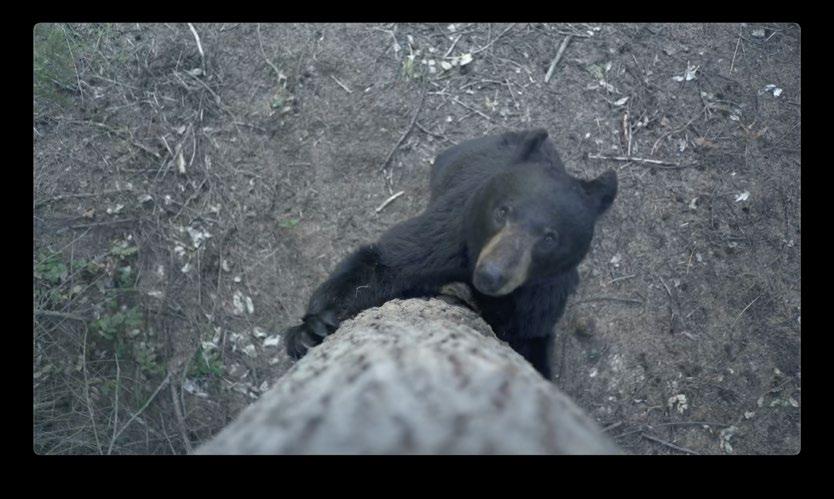
• Native fish surveys (including the federally listed bull trout), and aquatic invasive species monitoring.
• Bi-annual bird counts (Christmas Bird Count and Global Big Day) that play a part in citizen-science efforts. Additionally, our extensive work in land and wetland restoration has positively impacted habitat for fish, bird, amphibian, and mammal species.
The importance of wetlands spans across all species, non-human and human alike. Over the years SVC’s wetland projects have included restoration of altered wetlands, streams, and riparian areas, implementation of properly sized culverts for fish passage, construction of streamside fencing to prevent erosion from livestock, and planting of native flora along eroding streambanks. (See last fall’s issue of The Confluence to learn about the largest wetland restoration project in Montana’s history that SVC played a large part in.) Additionally, SVC conducts water quality analyses involving temperature, stream, and lake monitoring, and road restoration projects to reduce sediment in our waterways.
Conservation-minded land management is another pillar for our
Oily gaurd hairs cover minks’ bodies, making their coats waterproof and able to handle the chilly water temperatures, even in the dead of winter.
Similar to mountain lions, mink like to go for the neck (or skull) of their prey, which includes everything from fish to chipmunks to frogs and birds.
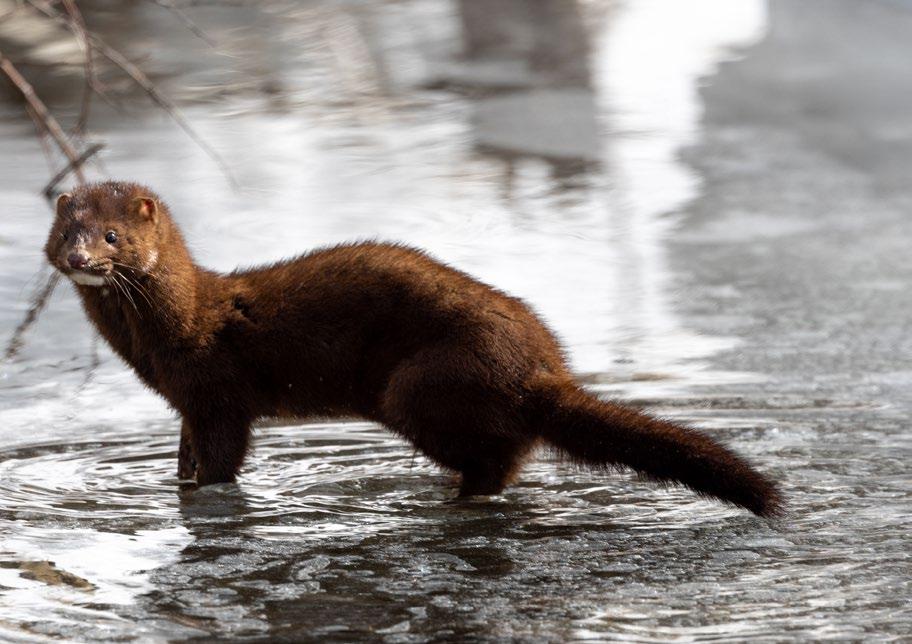
organization. Founders of Swan Valley Connections’ parent organizations, along with Trust for Public Lands and The Nature Conservancy, were part of the largest land purchase in Montana’s history, known as the Montana Legacy Project. The goal of this land acquisition was to protect valuable wildlife habitat and connectivity, protect the land from future development, and provide ample access to public lands. (See our Conservation Director’s article on the Montana Legacy Project in this issue of The Confluence.)
In 2006, SVC purchased the Elk Creek Conservation Area (ECCA) with the Confederated Salish and Kootenai Tribes. The ECCA is collaboratively managed with the CSKT perpetually to protect vital fish and wildlife habitat, as well as forest resources and public access. This square-mile parcel of land was deemed one of the most important bull trout spawning streams in Montana by the Department of Fish and Wildlife and Parks, and is protected by a Bonneville Power conservation easement.
In 2018 SVC was gifted the Swan Legacy Forest 1/4 section from The Nature Conservancy. This 160 acres is protected by a conservation easement held by the Montana Land Reliance, and is to be utilized for conservation, stewardship, and education in perpetuity.
Every conservation and education program we pursue is intrinsically tied to the wildlife that inhabit our shared landscape. The success of an ecologically intact ecosystem is mirrored in the success of our organization’s mission and is why we consider ourselves to be wild for wildlife.
Join us this November (1st-30th) for our annual Wild for Wildlife fundraising campaign, as we raise money to continue
the conservation and stewardship of this incredibly valuable place. Stay tuned throughout the month to see the best of our 2023 trail camera videos, featuring the wildlife that call the Swan Valley home!
Our goal this year is to raise $75,000, which includes up to $15,000 in match from the Cinnabar Foundation, up to $21,000 in match from our board of directors, and $12,000 in match for donations of $1,000 or more from a generous, anonymous donor! That’s a total of $36,000 for gifts of any size and $12,000 for gifts of $1,000 or more! If we actualize all of our match dollars, we’ll blow our goal out of the water. Invest in the wildlife of the Swan online at www. swanvalleyconnections.org/give or mail a check to our office at 6887 MT Hwy 83, Condon, MT 59826. Want to talk about a planned gift to create a legacy for wildlife forever? Thinking about making a tax-free gift from an IRA contribution? Get in touch with Rebecca at rebecca@svconnections.org or (406) 754-3137.
SVC recommends you consult with a qualified tax advisor about your specific circumstances for Qualified RMD Charitable Distributions.


SVC Board Vice-Chair and Swan Valley native Jessy Stevenson is multi-talented, to say the least. Among her many gifts is being an incredible artist and illustrator; if you’ve seen our updated Swan Valley Bear Resources logo, you know her work! We couldn’t be more proud to share her latest illustrations, which have been published in This is Wildfire, a book by Nick Mott and Justin Angle, inspired by the podcast Fireline, which also featured Jessy’s artwork. This is Wildfire explores the history, culture, ecology, and complex world of wildfire and what it means to live with fire in a rapidly changing world. Jessy shares why this project was so meaningful to her below:

In August of 2003, my sister and I watched the skies above the Mission Mountains fill with smoke from the Crazy Horse Fire. The drone of a backup water pump filled the usual quiet as our parents showed us how to extinguish embers that fell with the ash using wet towels. We were evacuated when the fire grew to 8,000 acres and stayed with friends across the valley while we waited to see what the wind would do. Thanks to the fire crews and an inversion that slowed the flames, we got to go home. In the 20 years that have passed, we’ve wondered each summer where the next fire would burn.
Fire was woven into our lives as kids growing up off-grid. We gathered wood in the warmer months to heat our house throughout the winter, learning which species sparked and which burned best. We huddled next to the wood cookstove on Sunday mornings, warming our backs and waiting for sourdoughs hot off the griddle. We fell asleep around countless campfires, listening to our parents, friends, and Elders tell stories about their smoke-jumping days and the landscapes that shape us, our jackets catching the occasional spark while the rest rose up to mingle with the stars. We found comfort in the smell of burning sweetgrass and learned how our ancestors used fire to improve grazing for the buffalo and habitat for plant
medicines. We collected morels where the Crazy Horse Fire had burned and grew to recognize the birds that made their homes in charcoal-stained snags. The land relied on fire for renewal as much as we relied on fire for warmth and food and medicines, and at some point, it clicked. If the landscapes that shape us are themselves shaped by fire, then fire is part of what shapes us. I didn’t go on to study fire or to become a wildland firefighter like so many family members and friends, but fire remained a constant in my life as summer skies grew thicker with smoke, and wildfires continued to burn hotter and more frequently across the globe. When I started a career in conservation, fire showed up as a central theme in almost every conversation on the intricate and complex relationships between people and place. As an artist and someone who grew up in a storytelling culture, I began to see fire as both a main character and an ever-present backdrop in the story of the West and other fire-dependent landscapes. So, when I was asked to create cover artwork for a podcast on wildfire and later invited to illustrate a book inspired by that podcast, the answer was easy. I worked with the authors and editors to draft concept sketches as fresh snow blanketed the hills around Missoula, and submitted final illustrations when Rattlesnake Creek began to swell with spring runoff. Throughout the summer, we waited - waited for publication day and waited to see what the everexpanding fire season would bring. As devastating wildfires broke out in Hawaii, Greece, California, and across the globe, and checking air quality indexes became part of the morning routine once more, the impacts of climate-driven wildfires and the critical need to reassess how we live in landscapes that depend on fire were felt more deeply than ever. While there is no single solution to the complex challenges we face, I believe that this book can serve as a valuable resource in our collective efforts to better understand and live with wildfire today.
This is Wildfire can be purchased wherever books are sold, including the SVC visitor center and website shop!
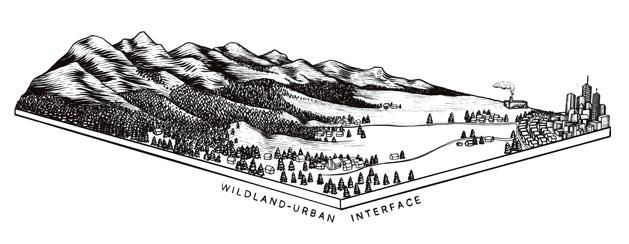
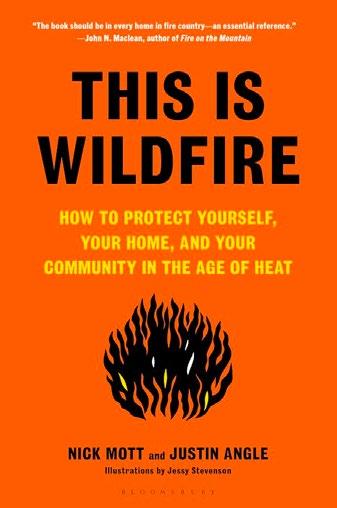
Please check our website or call (406) 754-3137 for the most up-to-date information.
November 1-30
Wild for Wildlife Fundraising Campaign
November 2
Mountain Goats with Jami Belt Community Potluck & Presentation
December 1
Winter programs scholarship deadline
December 2
Wildlife Tracks & Sign
December 9
Wildlife Tracks & Sign
January 6-14
Weeklong Wildlife Tracks & Sign College credit & CyberTracker certification



January 10
Community Potluck & Presentation (TBD - Traditional Ecological Knowledge)
January 15
Spring programs scholarship deadline
January 22
Bubble Cap Orders Open
February 3
Wildlife Tracks & Sign
February 24
Wildlife Tracks & Sign
Did you know daddy long-legs only have two eyes, don’t make silk, and aren’t true spiders?
Notice anything new? If you’ve been with us for more than a few years, then you’ve witnessed the evolution of The Confluence. What started as a newsletter has turned into a short publication. We’ve strived to continue to make it more beautiful and engaging for you, while keeping it affordable (aka free). But as the quality has gone up, so has the price to produce it. If you enjoy receiving The Confluence, we would love your financial support, so we can continue to make it happen for you. You can send a check with “newsletter printing” in the memo or make a contribution online at https://swan.app.neoncrm.com/forms/donate and leave us a note. And, of course, if you have any feedback you’d like to share, or if you’d like to go paperless and no longer want to receive a physical copy, let us know! We’re all ears.
